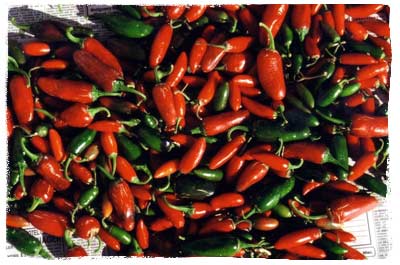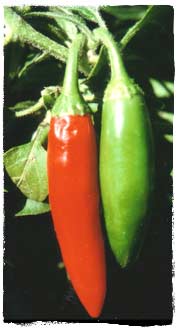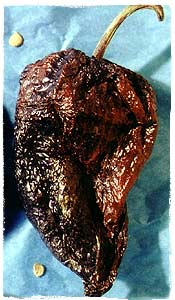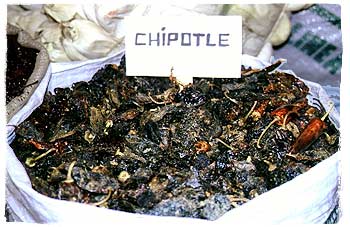by Dave DeWitt
|
Part 3: The Chiles in Chili
|
Recipes: Pods to Chili Powder Basic Chili Powder Homemade Hot Sauce |
In the construction of the perfect bowl of chili, we start with chile because without it, of course, carne would just be meat, not chili. Chile sets the course of chili much in the same way it directs famous hot and spicy dishes the world over–by dominating it with heat and flavor.
Chile “Science”
Any chili cook can look up heat levels of the various chiles and make a guestimate about the amount of any certain variety to use in a recipe, but such information will only be useful in a general sense. Chile peppers can vary in heat, even in the pods from the same plant. “The only consistency in chile peppers and chili powders seems to be in their inconsistency,” noted chili expert Floyd Cogan in his book, The Devil’s Sourcebook of Chili and Other Hellish Things. To truly hone the heat, experimentation with different combinations of chiles is the only path to take.
But at least the heat in chili is linear and has exact parameters ranging from hot to not so hot. The flavors of the myriads of chiles and their products, however, are a far more complicated story. R. F. Carlisle, a systems analyst who wrote a technical paper entitled “A Systems Engineering Analysis of a Process: How to Cook Winning Chili,” detailed three reasons why there is a wide inconsistency in the flavor of various chilis: “There is no standard in the classification of chili powders; chili powders lose flavor with time; and different chiles affect taste and aftertaste differently.”
Chef Mark Miller of the Coyote Café in Santa Fe has assembled a list of forty-one “Chile Flavor Descriptors,” which he divides into the categories of “fruity” and “other” flavors. The fruity flavors included citrusy (particularly orange and lemon), which would apply most varieties of habaneros and some of the yellow South American ajís, and raisin, which is the ever present aroma of the anchos and pasillas. Other fruity descriptors were black cherry, fig, mango, and melon. In the “other flavors” category, Miller lists chocolate, tobacco, tannic, soapy, green tea, and–ironically–black pepper.
Unfortunately, the science of chile flavors is still in its infancy, and most of the hundreds of chile varieties have not yet been matched to their flavor descriptors. However, chili chefs on the edge will certainly do more research into this important facet of chili flavor.
Below is an overview of the chiles most commonly used in chili. For more detailed information, there are reference works available on the identification and the heat and taste qualities of the various chiles. Recommended are Peppers: The Domesticated Capsicums, by Jean Andrews; The Whole Chile Pepper Book, by Dave DeWitt and Nancy Gerlach; and The Great Chile Book, by Mark Miller.
Fresh Chiles in Chili
Fresh chiles are often used in chilis because they are easily available from the garden or market. The most ubiquitous peppers in the United States, are, of course, the familiar bells, which have no heat unless they are a variety called Mexi-Bell, which has a mild bite. Bells rarely appear in western chilis, although they sometimes show up in eastern restaurants and competition chilis.
|
|
Fresh Red and Green Photo by Harald Zoschke
|
The long, green New Mexican chiles are used fresh, frozen, or canned as an ingredient in Southwestern chilis. The fresh New Mexican chiles must be roasted and peeled before using them in a recipe. Blistering or roasting the chile is the process of heating the chile to the point that the tough transparent skin is separated from the meat of the chile so it can be removed. The method is quite simple.
While processing the chiles, be sure to wear rubber gloves to protect yourself from the capsaicin that can burn your hands and any other part of your body that you touch. Before roasting, cut a small slit in the chiles close to the stem end so that the steam can escape. The chiles can then be placed on a baking sheet and put directly under the broiler or on a screen on the top of the stove. Or, place the pods on a charcoal grill about five to six inches from the coals. Blisters will soon indicate that the skin is separating, but be sure that the chiles are blistered all over or they will not peel properly. Immediately wrap the chiles in damp towels or place them in a plastic bag for ten to fifteen minutes–this “steams” them and loosens the skins. For crisper, less cooked chile, plunge them into ice-water to stop the cooking process.
The most readily available hot peppers in the produce sections of supermarkets are jalapeños and yellow wax peppers. Both are often floated whole in chilis to provide a little extra bite and are removed before serving. Some cooks remove the seeds and stems and mince them before adding them to the chili pot; other puree the peppers in a blender and then add them to the chili.
|
|
Jalapeño Harvest Photo by Dave DeWitt
|
Other fresh chiles used in chili that are sometimes found in markets (especially farmer’s markets) are serranos and habaneros. The serranos–smaller, thinner, and hotter than jalapeños–are the classic chiles of the Mexican pico de gallo fresh salsas. Habaneros, the world’s hottest peppers, are lantern-shaped orange or red devils that have a unique, fruity aroma in addition to their powerful punch. Use them with caution. Generally speaking, any of the small fresh peppers may be substituted for each other in chilis.
|
|
Habaneros in the Market Photo by Harald Zoschke
|
All of the smaller chiles–habaneros, serranos, and jalapeños–can be frozen without processing. Wash the chiles, dry them, and put them one layer deep on a cookie sheet and freeze. After they are frozen solid, store them in a bag. Frozen chiles will keep for nine months to a year at zero degrees F. All of the small peppers can be frozen whole with no further processing needed, and their texture holds up surprisingly well in the freezer–especially for use in chili.
|
|
Red and Green Serranos Photo by Dave DeWitt
|
The Dried Chiles in Chili
As is true with fresh peppers, the larger they are, the milder they are. The large dried peppers, such as ancho (a dried poblano) and the New Mexican varieties, are mild enough to add a lot of flavor to the chili without burning it up. They can be ground into powders (see below) or can be rehydrated and then pureed before adding them to the chili.
|
|
Ancho Chile Photo by Chel Beeson
|
There are four main large peppers used as the base for chilis: ancho, pasilla, New Mexican, and guajillo. The ancho is a wide, dark pepper with a “raisiny” aroma. It is the only pepper that is commonly stuffed in its dried form (the pod is softened in water first). The pasilla is a long, thin, dark pepper that also has a “raisiny” or nutty aroma. Along with the ancho, it commonly appears in Mexican mole sauces.
The most common use of the red New Mexican chiles is to hang them in long strings, or ristras, until they are ready to be used in cooking. Then, they are commonly rehydrated and combined with onions, garlic, oil, spices, and water and ground fine to make the classic New Mexican red chile sauce and stews. The guajillos, a shortened and hotter version of the New Mexican chiles, but grown in Mexico, are commonly used with anchos in chili-like stews in northern Mexico.
|
|
Ristra with Photos by Dave DeWitt
|
 |
There are a bewildering number of small, hot dried pods used in chili, ranging in size from that of a little fingernail (the chiltepin) to the six-inch, skinny cayenne. Some varieties include piquin, Thai, santaka, de arbol, mirasol, and tabasco. These chiles also appear in stir-fry dishes, are floated in soups or stews, or are used to add heat to sauces that are too mild. A specialized dried chile that has become quite popular in chilis is the chipotle, a smoke-dried red jalapeño that adds a distinctive, smoky flavor. Another specialized dry chile is chile pasado (chile of the past), which is New Mexican green chile which has been roasted, peeled, and dried in the sun. It is usually reconstituted in water, but some cooks add it directly to the chili pot.
|
|
Chipotles in the Market Photo by Dave DeWitt
|
Whichever chiles you choose for your chili, only practice will teach you how to use them. Red Caldwell, author of Pit, Pot and Skillet, advised: “You’ll discover that the more you use them, the easier they are to use. But remember the old line about how porcupines make love…carefully!”
Powdered Chiles in Chili
All chiles can be dried and ground into powder–and most are, including the hottest of all, the habanero. Crushed chiles, or those coarsely ground with some of the seeds are called quebrajado. Coarse powders are referred to as caribe, while the finer powders are termed molido. In our homes, we actually have more powders available than the whole pods because the powders are concentrated and take up less storage space. We store them in small, airtight bottles. The fresher the powders, the better they taste, so don’t grind up too many pods at once.
To grind the smaller chiles, first make certain they are completely dried and are so brittle that you can break them in half. Use an electric spice mill and be sure to wear a painter’s mask to protect your nose and throat from the pungent cloud of powder that you will create. The colors of the powders range from a bright, electric red-orange (chiltepins), to light green (dried jalapeños), to a dark brown that verges on black (ancho). Red pods can be made darker by dry-toasting them in skillet on top of the stove, stirring constantly.
To grind the larger chiles, first place them on a cookie sheet in a medium oven until they are brittle and break when bent. Be sure to turn them often so they don’t burn. Break the chiles into small pieces before grinding them. Occasionally, two steps are needed–a coarse grind in the blender and then a fine grind in the spice mill.
Some competition cooks grind their own secret blends of chiles that are added at the cook-off. John Thorne suggested that: “An ideal blend would start with a base of New Mexican chiles, mixed with some dark and wrinkled ancho chiles, (for their deep, earthy flavor), and one or two pasillas (for their nuttier piquancy). To this combination, add a controlled amount of one of the truly fiery peppers–de arbol or piquin to give the chili its true heat. The best powdered chile is made at home from a blend of different dried chiles–especially the milder ones. For while the fiery pods give chili myth and heat, the sweeter ones give it a depth of flavor.”
Chili Powders in Chili
These chili blends take powdered chiles a step further by adding spices. John Thorne warned about the commercial blends: “Ordinary chili powder is a predetermined mixture of powdered chile and seasoning; its familiar stale flavor and musty odor summons nostalgia and indigestion in equal proportion. Use it only as a last resort.”
Commercial chili powders are usually comprised of 80 to 85 percent powdered chiles, but they can contain up to 40 percent salt! Some unexpected spices also crop up, such as ginger, saffron, cinnamon, allspice, and anise. Other unneeded ingredients are maltodextrin, monosodium glutamate, and tricalcium phosphate.
Some chili experts, like Floyd Cogan, believe that some cooks will always use commercial blends. “If you are to have consistency in your attempts to make the perfect bowl of chili,” Cogan advises, “you must take into account that no two chili powders are alike. Stick with one brand of chili powder if you can.”
Many cooks grind their own blends of chiles and spice to make chili powder. The most common ingredients are chiles, paprika, garlic powder, ground oregano, salt, and cumin. Other occasional ingredients in home blends are turmeric, celery seed, cloves, coriander, sugar, and dried onion flakes. We have included two typical recipes for chili powder–but cooks are encouraged to experiment.
Chile Pulp in Chilis
Some of the older chili recipes call for chile pulp. To make the pulp, split New Mexican dried red chiles lengthwise, remove the stems and seeds, and soak in hot water for two hours. After rehydrating, the chile pulp can be scraped off the inside of the chiles with a dull knife and then strained. Another method is to tear up the chiles into small pieces, rehydrate them, and mash them through a sieve.
Hot Sauces in Chilis
There are a bewildering number of hot sauces manufactured throughout the world, and many of them are used by chili cooks. The sauces are basically grouped into the following categories: Louisiana, Caribbean, Mexican, and Asian. The Louisiana hot sauces are made out of tabasco or cayenne chiles, while the Caribbean sauces usually contain the various pod types of the Capsicum chinense species–commonly called “habaneros.” Mexican hot sauces contain a wide variety of chiles, from habaneros to de arbols to guajillos. Variations on them appear in the American Southwest and are often made with dried red New Mexican chiles. Asian hot sauces are made from the small, dried red pods grown in Southeast Asia, China, India, Malaysia, and Indonesia. Serranos, piquins, and cayennes are the American equivalents of the Asian chiles.
After hot sauce is added to chili, the taste of the concoction is affected to a limited degree by the type of chile used in the various sauces and more by the amount of vinegar the sauce contains. The vingear gives the chili more acidity, which affects the flavor components. Chili chefs should exercise caution when using hot sauces by adding them in stages and by tasting the chili after each addition.
Recipes
This fresh chili powder should be ground immediately before adding it to the chili.
-
4 ancho chiles, ground (see grinding instructions, above)
-
4 piquins or other small hot chiles, ground
-
2 tablespoons ground cumin seed
-
1 teaspoon oregano
-
1 teaspoon garlic powder
Place all ingredients in a spice mill and process until well mixed. Use immediately or store in a small, airtight jar.
Yield: 1/3 cup
Heat Scale: Medium
You can substitute ground piquin, santaka, or even habanero for the cayenne in this recipe.
-
1 tablespoon ground cayenne
-
1 tablespoon ground oregano
-
1 tablespoon paprika
-
1 teaspoon garlic powder
-
1 teaspoon salt
-
1 teaspoon ground cumin
Place all ingredients in a spice mill and process until well mixed. Use immediately or store in a small, airtight jar.
Yield: 1/4 cup
Heat Scale: Mild
Many chili cooks like to adjust the heat in their chili by adding various kinds of hot sauces. For the purists in the crowd who insist on making everything from scratch, here is our recipe for a homemade hot sauce. Any chiles of choice can be used. When substituting dry chiles for fresh ones, soak them in warm water for ½ hour to reconstitute them. For more body in this sauce, add the carrots. You can easily double or triple this recipe.
-
3/4 cup chopped onion
-
2 cloves garlic, minced
-
1 tablespoon vegetable oil
-
½ cup chopped carrots (optional)
-
10 small fresh hot chiles such as tabascos or piquins, chopped (or substitute 4 habaneros)
-
½ cup distilled vinegar
-
1/4 cup lime juice
-
Pinch salt
In a saucepan, saute the onion and garlic in the oil until soft. Add the carrots (if used) with a small amount of water. Bring to a boil, reduce, the heat and simmer until the carrots are soft.
Place the mixture and the fresh chiles in a blender and puree the mixture until smooth.
Combine the puree with the vinegar, lime juice, and salt and simmer for 5 minutes to combine the flavors.
Strain the mixture into sterilized bottles and seal.
Yield: 1½ cups
Heat Scale: Hot












